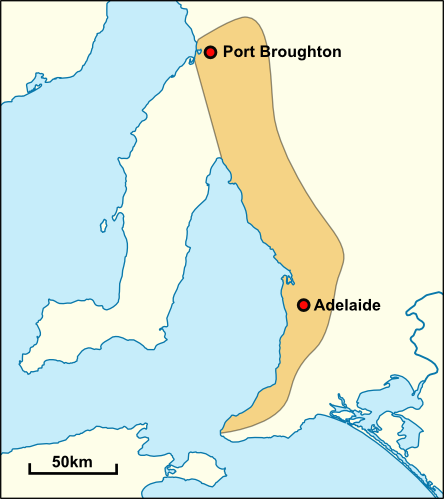|
Ronald Vernon Southcott
Ronald Vernon Southcott (15 May 1918 in Adelaide – 9 April 1998) was an Australian medical zoologist specializing in Acari, mites and ticks. Biography After finishing school at St Peter's College, Adelaide Southcott started working on mites, or the acari, at the age of 16 with Herbert Womersley the acarologist at the South Australian Museum. Womersley described and named the trombidiid mite, which Southcott had collected on a cycling trip in the hills near Adelaide in 1934, '' Microtrombidium southcotti'', after Southcott. Southcott considered that act by Herb Womersley, "hooked me on mites". Southcott studied medicine at the University of Adelaide where he graduated in 1941. Southcott then served in the Australian Army Medical Corps from 1942 to 1946. While he was stationed at Cairns he started working on the taxonomy and medical effects of jellyfish, the subject for which he was later to become famous. His more than 230 papers on the red mites include a classic revision of ... [...More Info...] [...Related Items...] OR: [Wikipedia] [Google] [Baidu] |
Adelaide
Adelaide ( ) is the list of Australian capital cities, capital city of South Australia, the state's largest city and the list of cities in Australia by population, fifth-most populous city in Australia. "Adelaide" may refer to either Greater Adelaide (including the Adelaide Hills) or the Adelaide city centre. The demonym ''Adelaidean'' is used to denote the city and the residents of Adelaide. The Native title in Australia#Traditional owner, Traditional Owners of the Adelaide region are the Kaurna people. The area of the city centre and surrounding parklands is called ' in the Kaurna language. Adelaide is situated on the Adelaide Plains north of the Fleurieu Peninsula, between the Gulf St Vincent in the west and the Mount Lofty Ranges in the east. Its metropolitan area extends from the coast to the Adelaide Hills, foothills of the Mount Lofty Ranges, and stretches from Gawler in the north to Sellicks Beach in the south. Named in honour of Queen Adelaide, the city was founded ... [...More Info...] [...Related Items...] OR: [Wikipedia] [Google] [Baidu] |
Zoologist
Zoology ()The pronunciation of zoology as is usually regarded as nonstandard, though it is not uncommon. is the branch of biology that studies the animal kingdom, including the structure, embryology, evolution, classification, habits, and distribution of all animals, both living and extinct, and how they interact with their ecosystems. The term is derived from Ancient Greek , ('animal'), and , ('knowledge', 'study'). Although humans have always been interested in the natural history of the animals they saw around them, and made use of this knowledge to domesticate certain species, the formal study of zoology can be said to have originated with Aristotle. He viewed animals as living organisms, studied their structure and development, and considered their adaptations to their surroundings and the function of their parts. The Greek physician Galen studied human anatomy and was one of the greatest surgeons of the ancient world, but after the fall of the Western Roman Empire ... [...More Info...] [...Related Items...] OR: [Wikipedia] [Google] [Baidu] |
Acari
Mites are small arachnids (eight-legged arthropods). Mites span two large orders of arachnids, the Acariformes and the Parasitiformes, which were historically grouped together in the subclass Acari, but genetic analysis does not show clear evidence of a close relationship. Most mites are tiny, less than in length, and have a simple, unsegmented body plan. The small size of most species makes them easily overlooked; some species live in water, many live in soil as decomposers, others live on plants, sometimes creating galls, while others again are predators or parasites. This last type includes the commercially destructive '' Varroa'' parasite of honey bees, as well as scabies mites of humans. Most species are harmless to humans, but a few are associated with allergies or may transmit diseases. The scientific discipline devoted to the study of mites is called acarology. Evolution and taxonomy The mites are not a defined taxon, but is used for two distinct groups of ... [...More Info...] [...Related Items...] OR: [Wikipedia] [Google] [Baidu] |
St Peter's College, Adelaide
, other_name = The Collegiate School of St Peter , seal_image = St Peter's College, Adelaide Logo.svg , seal_size = 150 , image = SPSC chapel and memorial hall.jpg , image_size = , motto = la, Pro Deo et Patria , motto_translation = For God and Country , established = , type = Independent primary and secondary day and boarding school , gender = Boys , denomination = Anglican , headmaster = Tim Browning , chaplain = Theo McCall , enrolment = 1,497 , enrolment_as_of = 2018 , grades = R–Year 12 , grades_label = Years , colours = Royal blue and white , houses = Da Costa Farr Farrell Hawkes Howard MacDermott School & Allen Short Woodcock Young , campus = Hackne ... [...More Info...] [...Related Items...] OR: [Wikipedia] [Google] [Baidu] |
Herbert Womersley
Herbert Womersley (1889–1962) was an entomologist whose works were especially concerned with mites and ticks, silverfish and flies. His research into the diversity of Australian resulted in descriptions of new insect taxa. Biography Womersley was enlisted for wartime service in two English military sections, during 1915 to 1917 in the Royal Army Medical Corps and the Chemical Corps, Royal Engineers. After volunteering to join the chemical engineers, Womersley was engaged to transport tanks of poisons toward the frontlines of battle and release phosgene, chlorine and other weaponised gases when the prevailing wind became unfavourable to the enemy. Womersley was involved in the earliest chemical weapon attacks on German troops during the European conflict, including the first British use at the Battle of Loos. He served next at the munitions factory, H.M. Factory Gretna as a chemist until the end of the war. His later employment in Britain included a soap manufacturer and p ... [...More Info...] [...Related Items...] OR: [Wikipedia] [Google] [Baidu] |
South Australian Museum
The South Australian Museum is a natural history museum and research institution in Adelaide, South Australia, founded in 1856 and owned by the Government of South Australia. It occupies a complex of buildings on North Terrace in the cultural precinct of the Adelaide Parklands. Plans are under way to move much of its Australian Aboriginal cultural collection (the largest in the world), into a new National Gallery for Aboriginal Art and Cultures. History 19th century There had been earlier attempts at setting up mechanics' institutes in the colony, but they struggled to find buildings which could hold their library collections and provide spaces for lectures and entertainments. In 1856, the colonial government promised support for all institutes, in the form of provision the first government-funded purpose-built cultural institution building. The South Australian Institute, incorporating a public library and a museum, was established in 1861 in the rented premises of ... [...More Info...] [...Related Items...] OR: [Wikipedia] [Google] [Baidu] |
University Of Adelaide
The University of Adelaide (informally Adelaide University) is a public research university located in Adelaide, South Australia. Established in 1874, it is the third-oldest university in Australia. The university's main campus is located on North Terrace in the Adelaide city centre, adjacent to the Art Gallery of South Australia, the South Australian Museum, and the State Library of South Australia. The university has four campuses, three in South Australia: North Terrace campus in the city, Roseworthy campus at Roseworthy and Waite campus at Urrbrae, and one in Melbourne, Victoria. The university also operates out of other areas such as Thebarton, the National Wine Centre in the Adelaide Park Lands, and in Singapore through the Ngee Ann-Adelaide Education Centre. The University of Adelaide is composed of three faculties, with each containing constituent schools. These include the Faculty of Sciences, Engineering and Technology (SET), the Faculty of Health and Medi ... [...More Info...] [...Related Items...] OR: [Wikipedia] [Google] [Baidu] |
Australian Army Medical Corps
The Royal Australian Army Medical Corps (RAAMC) is the branch of the Australian Army responsible for providing medical care to Army personnel. The AAMC was formed in 1902 through the amalgamation of medical units of the various Australian colonies and was first deployed to South Africa as a small detachment of personnel supporting the Australian Commonwealth Horse during the Second Boer War. The corps has participated in every Australian Army operation since then, including wars and peacekeeping operations. The "Royal" prefix was granted in 1948. History The Australian Army Medical Corps was formed on 1 July 1902 by combining the medical services of the armed forces of the various Australian colonies that had been in existence prior Federation, which had their origins in the medical structures of the British forces that had deployed to Australia during the late 18th and early 19th centuries. The corps' first deployment was to the Second Boer War, where it provided a field hos ... [...More Info...] [...Related Items...] OR: [Wikipedia] [Google] [Baidu] |
Cnidaria
Cnidaria () is a phylum under kingdom Animalia containing over 11,000 species of aquatic animals found both in Fresh water, freshwater and Marine habitats, marine environments, predominantly the latter. Their distinguishing feature is cnidocytes, specialized cells that they use mainly for capturing prey. Their bodies consist of mesoglea, a non-living jelly-like substance, sandwiched between two layers of epithelium that are mostly one cell (biology), cell thick. Cnidarians mostly have two basic body forms: swimming Medusa (biology), medusae and Sessility (motility), sessile polyp (zoology), polyps, both of which are Symmetry (biology)#Radial symmetry, radially symmetrical with mouths surrounded by tentacles that bear cnidocytes. Both forms have a single Body orifice, orifice and body cavity that are used for digestion and respiration (physiology), respiration. Many cnidarian species produce Colony (biology), colonies that are single organisms composed of medusa-like or polyp (z ... [...More Info...] [...Related Items...] OR: [Wikipedia] [Google] [Baidu] |
Chironex Fleckeri
''Chironex fleckeri'', commonly known as the Australian box jelly, and nicknamed the sea wasp, is a species of extremely venomous box jellyfish found in coastal waters from northern Australia and New Guinea to Malaysia, the Philippines and Vietnam.Fenner, P. J. (2000). Chironex fleckeri – the north Australian box-jellyfish.' marine-medic.com It has been described as "the most lethal jellyfish in the world", with at least 64 known deaths in Australia from 1884 to 2021. Notorious for its sting, ''C. fleckeri'' has tentacles up to long covered with millions of cnidocytes which, on contact, release microscopic darts delivering an extremely powerful venom. Being stung commonly results in excruciating pain, and if the sting area is significant, an untreated victim may die in two to five minutes.Biology, 7ed. Campell & Reece The amount of venom in one animal is said to be enough to kill 60 adult humans. Taxonomy ''Chironex fleckeri'' was named after North Queensland toxicologis ... [...More Info...] [...Related Items...] OR: [Wikipedia] [Google] [Baidu] |
Hypervitaminosis A
Hypervitaminosis A refers to the toxic effects of ingesting too much preformed vitamin A (retinyl esters, retinol, and retinal). Symptoms arise as a result of altered bone metabolism and altered metabolism of other fat-soluble vitamins. Hypervitaminosis A is believed to have occurred in early humans, and the problem has persisted throughout human history. Toxicity results from ingesting too much preformed vitamin A from foods (such as fish liver or animal liver), supplements, or prescription medications and can be prevented by ingesting no more than the recommended daily amount. Diagnosis can be difficult, as serum retinol is not sensitive to toxic levels of vitamin A, but there are effective tests available. Hypervitaminosis A is usually treated by stopping intake of the offending food(s), supplement(s), or medication. Most people make a full recovery. High intake of provitamin carotenoids (such as beta-carotene) from vegetables and fruits does not cause hypervitaminosis A. ... [...More Info...] [...Related Items...] OR: [Wikipedia] [Google] [Baidu] |


_Lorryia_formosa_2_edit.jpg)



